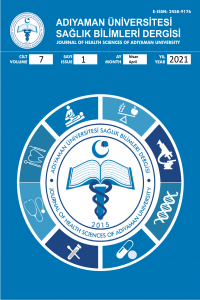Derin Anemi Nedeniyle Hastanede Yatan İnfant Hastaların Etiyolojik Açıdan İncelenmesi
Beslenme bozukluğu, derin anemi, sosyoekonomik düzey, süt çocuğu
Etiological Investigation of the Inpatient Infants due to Severe Anemia
Infant, malnutrition, severe anemia, socioeconomic status,
___
- 10. Şimşek Ö, Büyükavcı M, Kaya MD, Akdağ R, Karakelleoğlu C. Orta derecede rakımda yaşayan Erzurum ve pediatri polikliniğine başvuran 6 ay-6 yaş arasındaki çocuklarda anemi prevalansı ve etyolojik faktörler. Zeynep Kamil Bülteni 2005;36:33-8.
- 11. Kapil U, Tyagi M. Etiology of severe anemia amongst adolescent children. Indian J Pediatr 2012;79:401-2.
- 12. Baker RD, Greer FR. Diagnosis and prevention of iron deficiency and ıron deficiency anemia in infants and young children. Pediatrics 2010;126:1040-1050.
- 13. Charles CV, Summerlee AJ, Dewey CE. Anemia in Cambodia: prevalence, etiology and research needs. Asia Pac J Clin Nutr 2012;21(2):171-81.
- 14. Reeve K, Jones H, Hatrey R. Transfüsion guidelines in children:1. Anaesth Intensive Care 2014;13:20-23.
- 15. Kılıçaslan Ö, Yıldırmak ZY, Urgancı N. Derin anemi nedeni ile çocuk kliniğine yatırılıp demir eksikliği tanısı alan olguların değerlendirilmesi. Ş.E.E.A.H. Tıp Bültesi 2014;48:234-8.
- 16. Yüksel Ş, Uslan İ, Acartürk G, Çölbay M, Karaman Ö, Maralcan M, Demir S. A Retrospective Evaluation of Patients with Vitamin B12 Deficiency. Medical Journal of Bakırköy 2006;2:126-9.
- 17. Stevens GA, Finucane MM, De-Regil LM, Paciorek CJ, Flaxman SR, Branca F, Peña-Rosas JP, Bhutta ZA, Ezzati M; Nutrition Impact Model Study Group (Anaemia). Global, regional, and national trends in haemoglobin concentration and prevelence of total and severe anaemia in children and pregnant and non-pregnant women for 1995-2011: a systematic analysis of population-representative data. Lancet Glob Health 2013;1(1):16-25.
- 18. Patra S, Pemde HK, Singh V, Chandra J, Dutta A. Profile of adolescents with severe anemia admitted in a tertiary care hospital in Northern India. Indian J Pediatr 2011;78(7):863-5.
- 19. Alvarez-Uria G, Naik PK, Midde M, Yalla PS, Pakam R. Prevalence and severity of anaemia stratified by age and gender in Rural India. Anemia 2014;2014:176182.
- 1. Sullivan KM, Mei Z, Grummer-Strawn L, Parvanta I. Haemoglobin adjustments to define anaemia. Trop Med Int Health 2008;13(10):1267-71.
- 2. WHO’s Certified[ Internet]. Vitamin and Mineral Nutrition Information System [Internet] Switzerland: Hemoglobin concentrations for the diagnosis of anemia and assesment of severity. C 2000-1. Availabel from: http://www.who.int/vmnis/indicators/haemoglobin.
- 3. Hensbrock MB, Jonker F, Bates I. Severe acquired anaemia in Africa: new concepts. Br J Haematol 2011;154:690-95.
- 4. Sloniewsky D. Anemia and transfusion in critically ill pediatric patients: a review of etiology, management, and outcomes. Crit Care Clin 2013;29(2):301-17.
- 5. Özdemir N. Iron deficiency anemia from diagnosis to treatment in children. Turk Pediatri Ars 2015;50(1):11–9.
- 6. Baumgartner MR. Vitamin-responsive disorders: cobalamin, folate, biotin, vitamins B1 and E. Handb Clin Neurol 2013;113:1799-810.
- 7. Loiselle K, Lee JL, Szulczewski L, Drake S, Crosby LE, Pai AL. Systematic and Meta-Analytic Review: Medication Adherence Among Pediatric Patients With Sickle Cell Disease. J Pediatr Psychol 2016;41(4):406-18.
- 8. Pasricha SR, Drakesmith H. Iron Deficiency Anemia: Problems in Diagnosis and Prevention at the Population Level. Hematol Oncol Clin North Am 2016;30(2):309-25.
- 9. Güvenç H, Aygün AD, Soylu F, Kocabay K. Çocukluk döneminde derin anemi etyolojisinde demir eksikliğinin önemi. MN Pediatri 1994;1:149-52.
- Yayın Aralığı: Yılda 3 Sayı
- Başlangıç: 2015
- Yayıncı: ADIYAMAN ÜNİVERSİTESİ
Derin Anemi Nedeniyle Hastanede Yatan İnfant Hastaların Etiyolojik Açıdan İncelenmesi
Fatih İŞLEYEN, Mehmet TEKİN, Çapan KONCA
Postmenopozal Kadınlarda Balık tüketiminin Kemik Mineral Yoğunluğu Üzerine Etkisi
Bupropion Kullanımına Bağlı Asemptomatik Transaminaz Yükselmesi: Olgu Sunumu ve Literatür Taraması
Osman Hasan Tahsin KILIÇ, İhsan AKSOY, Bahadır DEMİR
Barsak Obstrüksiyonu Bulguları ile Başvuran Pediatrik Meckel Divertikülit Olgusu
Mehmet ŞİRİK, Musa ABEŞ, İbrahim İNAN, Hasan Öğünç APAYDIN, Ali Haydar BAYKAN, Safiye KAFADAR
Muhammet Zeki GÜLTEKİN, Ender ALAGÖZ, Serdar YÜKSEL, Şule ÖZSOY, Ali AVCI, Mehmet Akif GÜLEÇ, Oğuz UĞUR
NORMAL KARACİĞER, BÖBREKLER VE DALAK PARANKİMİNİN ORTALAMA ADC DEĞERLERİNİN HESAPLANMASI
